Weed management in potato crops is crucial for ensuring a global staple. Weeds pose a significant challenge in potato production worldwide. They stifle potato plant growth and diminish potato product yields and quality. Effective weed control is necessary to achieve high-quality and abundant potato crops.
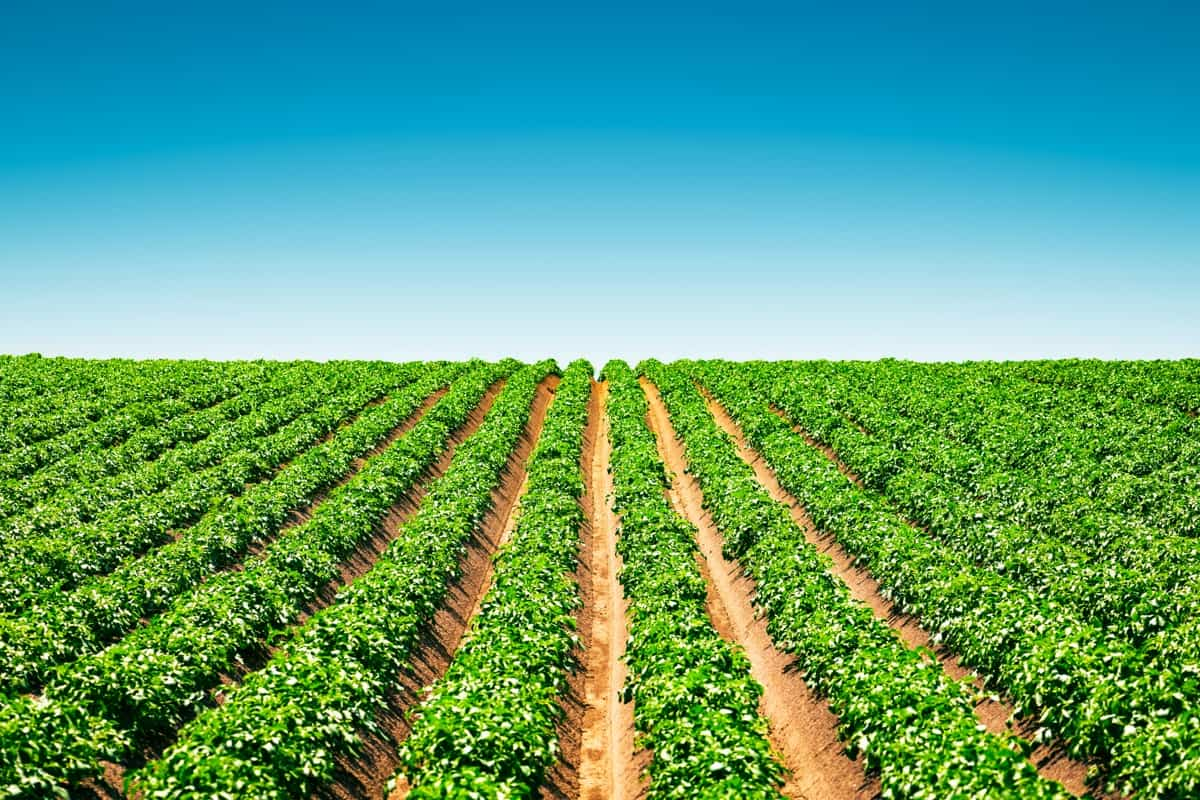
Common weeds that invade potato fields compete for nutrients and resources, resulting in yield and product quality losses. We also delve into the extent of weed infestation-related yield loss. Various control methods are discussed to combat these issues, including preventive measures, cultural practices, mechanical methods, chemical herbicides, and integrated weed management.
Weed Management in Potato
What is Weed Management in Potato Crop?
Weed management in potato cultivation is a multifaceted process that considers various factors. These include the types of weeds present, crop rotation, cultivation techniques, the availability of herbicides, and the competitive strength of the potato crop. Early-season weeds must be controlled within 4 to 6 weeks after potato emergence to prevent them from negatively impacting yields.
Weeds that appear after the potato vines cover the rows generally don’t compete with the crop but can hinder harvest and lead to seed production, causing problems in future crops. Weeds become a greater concern if adverse conditions delay crop growth.
In case you missed it: High-Yielding Potato Varieties in India: Hybrid Cultivars for Increased Profits
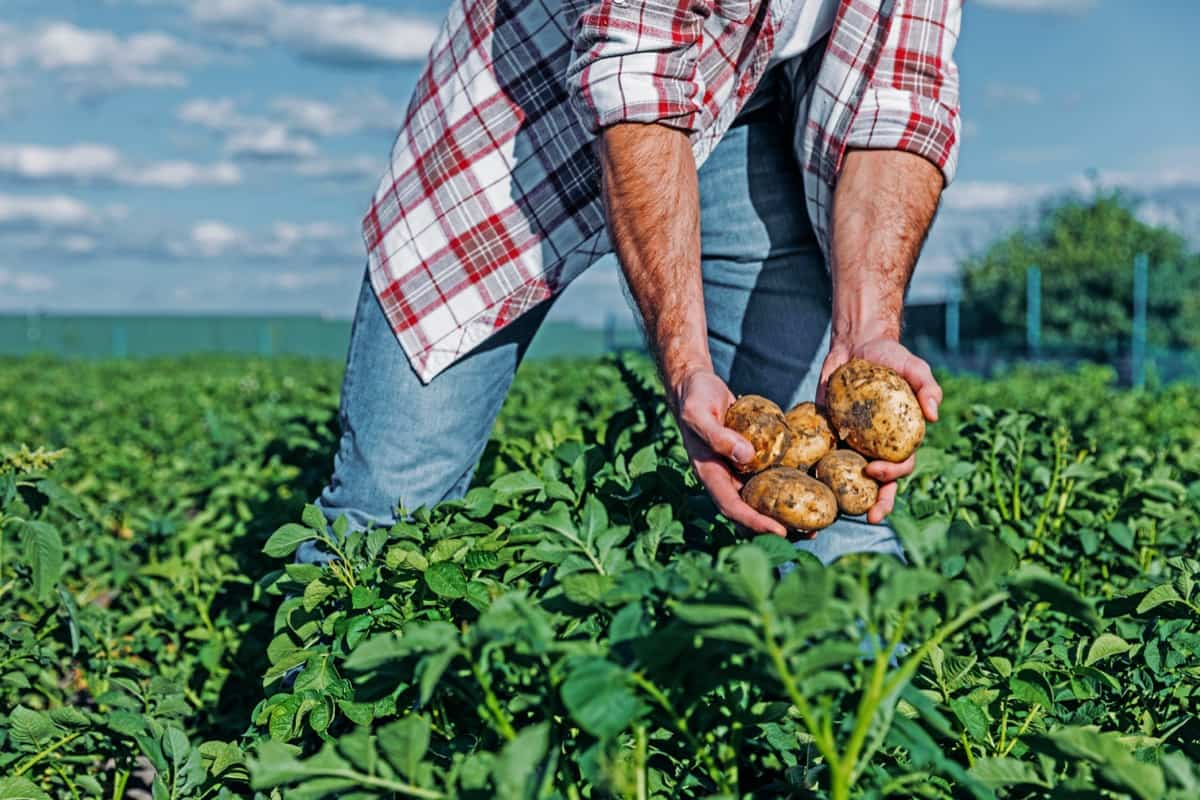
Common Weeds in Potato Crop
- Barnyardgrass (Echinochloa crus-galli): A tall grass with wide, flat leaves and a distinctive seed head resembling a turkey foot.
- Bermudagrass (Cynodon dactylon): Low-growing grass with fine blades and a creeping habit.
- Field Bindweed (Convolvulus arvensis): Vines with arrowhead-shaped leaves and trumpet-like white or pink flowers.
- Annual Bluegrass (Poa annua): Small grass with fine leaves and seed heads resembling tiny green tufts.
- Wild Buckwheat (Polygonum convolvulus): Broad, heart-shaped leaves and clusters of small, pinkish-white flowers.
- Cudweeds (Gnaphalium spp.): Small, greyish plants with woolly leaves.
- Dodders (Cuscuta spp.): Leafless, twining vines that wrap around host plants.
- Coast Fiddleneck (Amsinckia menziesii var. intermedia): Fern-like leaves and coiled flower clusters.
- Foxtails (Setaria spp.): Grasses with bushy seed heads that resemble fox tails.
- Johnsongrass (Sorghum halepense): Tall grass with large, broad leaves and distinctive seed heads.
- Common Knotweed (Polygonum arenastrum): Low-growing with lance-shaped leaves and pink or white flowers.
- Common Lambsquarters (Chenopodium album): Silvery-grey leaves with a mealy texture.
- Mustards (Brassica spp.): Typically, they have clusters of small yellow flowers.
- Burning Nettle (Urtica urens): Stinging, serrated leaves and small green flowers.
- Black Nightshade (Solanum nigrum): Small shrub-like plant with white flowers and small black berries.
- Purple Nutsedge (Cyperus rotundus): Grass-like with triangular stems and tubers.
- Wild Oat (Avena fatua): Grass with loose clusters of oat-like seeds.
- Pigweeds (Amaranthus spp.): Typically have spiky clusters of small flowers.
Weed Management Before Planting Potatoes
Crop Rotation
Crop rotation is a fundamental practice in weed management. Cereals like small grains, corn, and sorghum (milo) are valuable choices for rotation. Importantly, herbicides that can’t be used in potatoes for safety or regulatory reasons can be employed in these crops to control problematic weeds.
After harvesting these grains, perennial weeds can be managed by plowing and watering to encourage weed growth in the fall, followed by applying postemergence herbicides. Additionally, dry or irrigated following after May/June harvests in Kern County can effectively control numerous weeds. Crop rotations aid in weed control and help manage diseases and nematode issues.
Alfalfa as a Rotation Crop
On soils that are less suitable for short rotations of potatoes, alfalfa is a valuable rotation crop. It shades out many annual weeds, and regular alfalfa mowing helps eliminate emerging weeds before they produce seeds, reducing infestations of troublesome weeds. However, it’s important to note that some root-knot nematode species can affect alfalfa, which may limit its utility in potato rotations.
Crops closely related to potatoes, such as tomatoes, peppers, and eggplants, are generally not recommended for rotation due to the similarity in available herbicides. This similarity restricts the effectiveness of herbicide mode of action rotation, a strategy used to prevent or delay herbicide resistance development.
Cultivation
It’s crucial to till potato fields after the harvest of previous crops. This practice helps reduce the production of weed seeds or propagules. Additional tillage may be necessary if weeds grow and approach their reproductive stages before potato planting, ensuring a weed-free start.
In case you missed it: How to Treat Sweet Potato Pests and Diseases: Management, Control, and Prevention
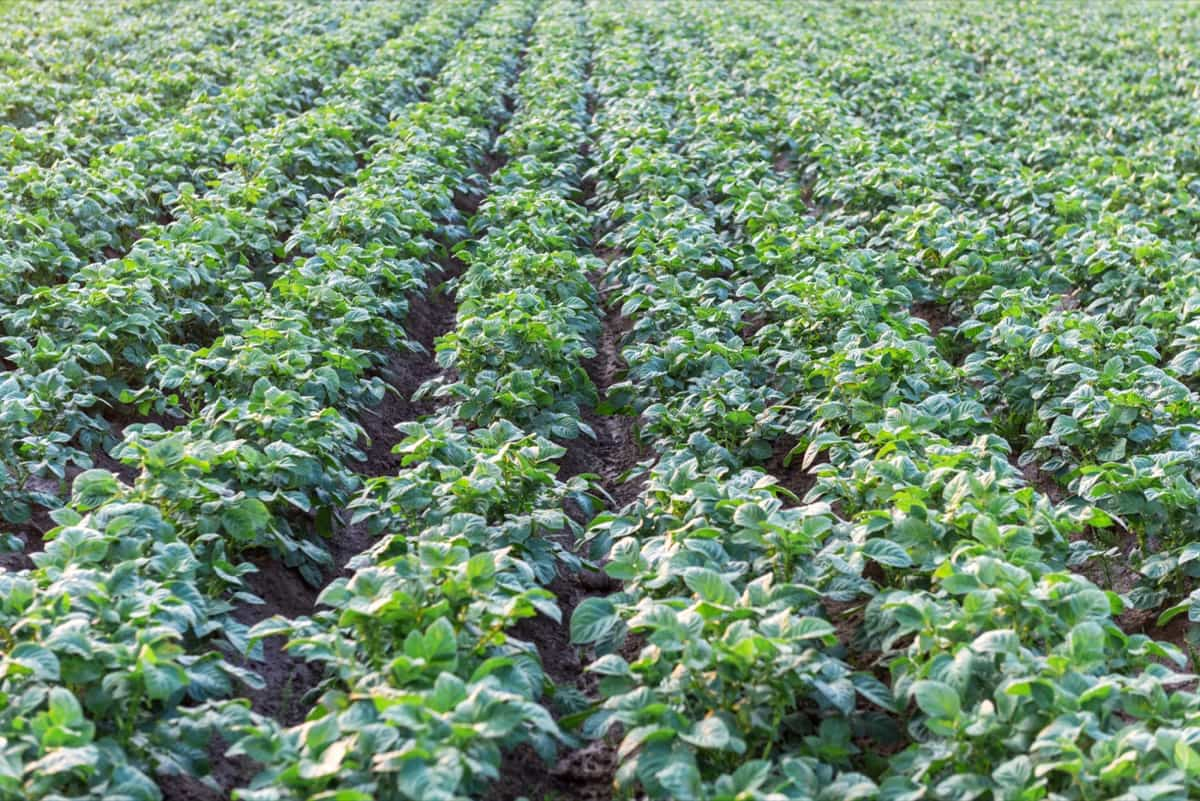
Herbicides
Employing preplant herbicides is a key part of weed management. These herbicides are used during field preparation or fertilizer application before planting potatoes. Preplant, soil-active herbicides are usually mechanically incorporated into the soil or applied through sprinkler irrigation before weed emergence. This approach targets germinating weed seeds or young seedlings, preventing their growth.
Nonselective foliar-active herbicides like paraquat and glyphosate can also be applied before planting to control emerged weeds. In the County, controlling nutsedge is a critical concern. The soil-active herbicide EPTC is typically applied by March 1 to tackle this weed. It can be applied before or after planting, with multiple applications often required throughout the season.
In Siskiyou and Modoc County, metribuzin is a suitable choice for weed control. Preemergent weed control tank mixes are also commonly used. These combinations often include trifluralin and EPTC or pendimethalin and EPTC. By using these herbicide mixes, growers can effectively manage weed growth early, ensuring that the potato crop gets a strong start.
Weed Management After Planting in Potato Fields
Planting schedules are optimized to take advantage of the competitive nature of potatoes. For spring potatoes planted in winter, cultivation during the winter just before potato emergence until the plants reach 4- to 8-inch height helps eliminate winter weeds and the initial spring weed growth. February plantings require cultivation just before emergence to the 4- to 8-inch stage for season-long control of most annual weeds, with exceptions like nutsedges.
In summer plantings, where rapid weed growth occurs due to intense heat, timely cultivation of small weeds is crucial. Multiple cultivations may be needed to address successive weed flushes, and delaying irrigation post-cultivation prevents re-rooting and new weed germination. Growers often avoid cultivation after potatoes have significant shoot and root development to prevent root pruning and shoot damage.
The risk of reduced yields or quality due to irrigation disruptions is a concern. Timely and shallow cultivation, about 3 to 5 days following irrigation, is advised. Soil compaction can also be a problem with excessive tillage. Well-timed cultivations play a pivotal role in reducing the need for chemical control. Postplant hilling cultivations can eliminate emerged weeds, but it’s effective when weeds are less than 1 inch tall.
Second cultivations or foliar-active herbicides can tackle later-emerging weed seedlings. Early cultivation reduces weed pressure and the size of weeds requiring control. Cultivating in relatively dry soil is essential to maximize effectiveness and minimize compaction. After cultivation, fields should not be irrigated for at least 24 hours to desiccate uprooted weeds.
Herbicides for Weed Management in Potato Fields
Preemergence Herbicides
- Timing is crucial, typically within the first three weeks after planting.
- They can be incorporated into the soil through sprinkler irrigation or mechanical cultivation.
- Application after the last cultivation is preferred to avoid disturbing treated soil.
- Safe to emerge potatoes when applied two to three weeks after planting.
- Postemergence, foliar-active herbicides should be added to the mix if emerged weeds are present.
Nonselective Postemergence Herbicides
- Options include paraquat, glyphosate, or carfentrazone.
- Apply after planting but before crop emergence to avoid crop injury.
- Rimsulfuron and metribuzin have soil and foliar activity, suitable before or after weed or potato emergence.
- Rimsulfuron is often split-applied before and after potato emergence.
- Check potato variety tolerance before using metribuzin.
In case you missed it: How to Fix Potassium Deficiency in Soil and Plants: Causes, Symptoms, Adding Naturally, and Chemically
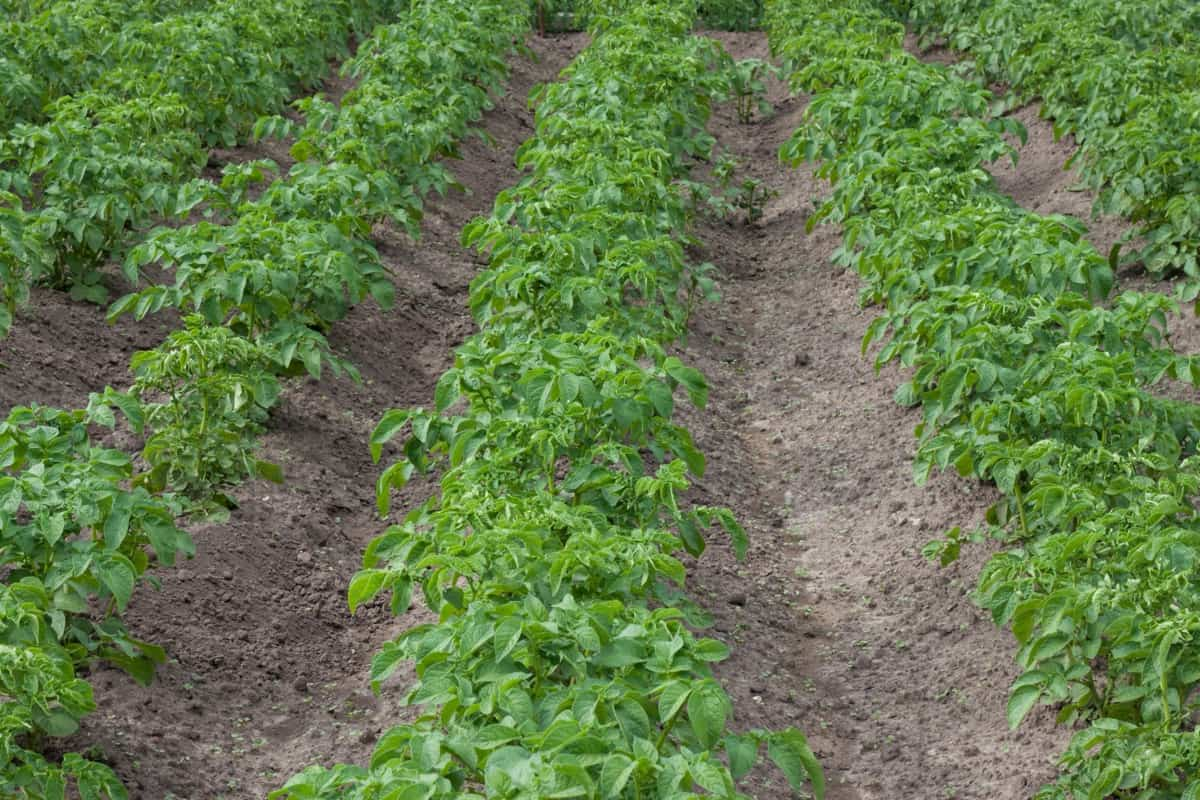
Selective Postemergence Grass Herbicides
- Clethodim or sethoxydim can be used to control grass weeds.
- Killing potato vines before senescence can aid tuber maturity and weed control.
- Methods include flail mowing, rolling, and chemical desiccation.
- Prevents weeds from interfering with mechanical harvest and inhibits weed maturity and seed production.
- S-metolachlor (Dual Magnum II) was applied to the soil surface before potato emergence for nightshade and nutsedge control.
- Incorporate by sprinkler irrigation or shallow tillage.
- Dimethenamid-p and pendimethalin can also be used preemergence on high organic matter soils.
- Use the high rate of dimethenamid-p, followed by rainfall, irrigation, or shallow mechanical incorporation.
- For soils with over 0.5% organic matter, consider postemergence metribuzin, metribuzin, and rimsulfuron combination for emerged broadleaf weed control.
- EPTC application after preplant can follow sequentially after planting using rolling cultivators or chemigation through solid set sprinklers.
- Follow label instructions carefully due to EPTC’s volatility.
- Pendimethalin or trifluralin may not be needed if EPTC is used sequentially.
- Pendimethalin used postplant with EPTC helps suppress nightshade.
- On high organic matter soils, control may only be partial.
- A tank mix of pendimethalin and dimethenamid-p can be beneficial, offering better control than either product alone.
- Note that dimethenamid-p must be applied as preemergence to potatoes.
- Avoid applying pendimethalin after potatoes reach 6 inches in height.
- On winter plantings, use paraquat to control emerged nettle and winter mustards before potato emergence.
Special Weed Problems in Potato Fields
Nightshade
To control nightshade species (like hairy, black, and cutleaf nightshade), effective crop rotation is key. Choose crops such as corn, sorghum, cereals, or sugar beets that can be managed with herbicides targeting nightshades. Nightshades produce a lot of seeds, and once their numbers increase, it may take several rotations to reduce infestations. Control methods include tillage, using multiple herbicides effective against nightshades, and several herbicide applications. Dimethenamid-p, flumioxazin, and rimsulfuron are effective herbicides for hairy and black nightshade.
Nutsedge
Yellow nutsedge is a significant issue in Kern County. Effective management is essential to prevent its rhizomes from penetrating potato tubers, which can reduce quality. Nutsedge doesn’t tolerate shade, so nutsedge growth is usually suppressed once potato vines cover the rows.
In areas where nutsedges emerge before row closure, consider preemergence EPTC application before March 1 and, if necessary, apply EPTC again after about a month. In high organic matter soils, use s-metolachlor before potato emergence. Thoroughly apply vine-killing agents before harvest to suppress nutsedge growth.
Quackgrass
Quackgrass is problematic in northern California potato-growing regions. Its rhizomes can penetrate potato tubers, lowering quality. Preplant EPTC application, with deep tilling, can suppress quackgrass growth for a season but not eradicate it. Glyphosate can control actively growing quackgrass before planting. After planting, clethodim or sethoxydim may be used to address quackgrass problems, with sequential treatments often necessary.
Herbicides Safe for Use on Potatoes
Preplant or Fallow Herbicides
- Carfentrazone (Shark EW): Apply before planting potatoes. It belongs to WSSA Mode-of-Action Group Number 14.
- Trifluralin (Treflan HFP): Apply preplant only, tank-mixed with EPTC. Incorporate it into the soil within 24 hours of application.
In case you missed it: Top 20 Steps to Boost Potato Yield: How to Increase Production, Size, and Quality
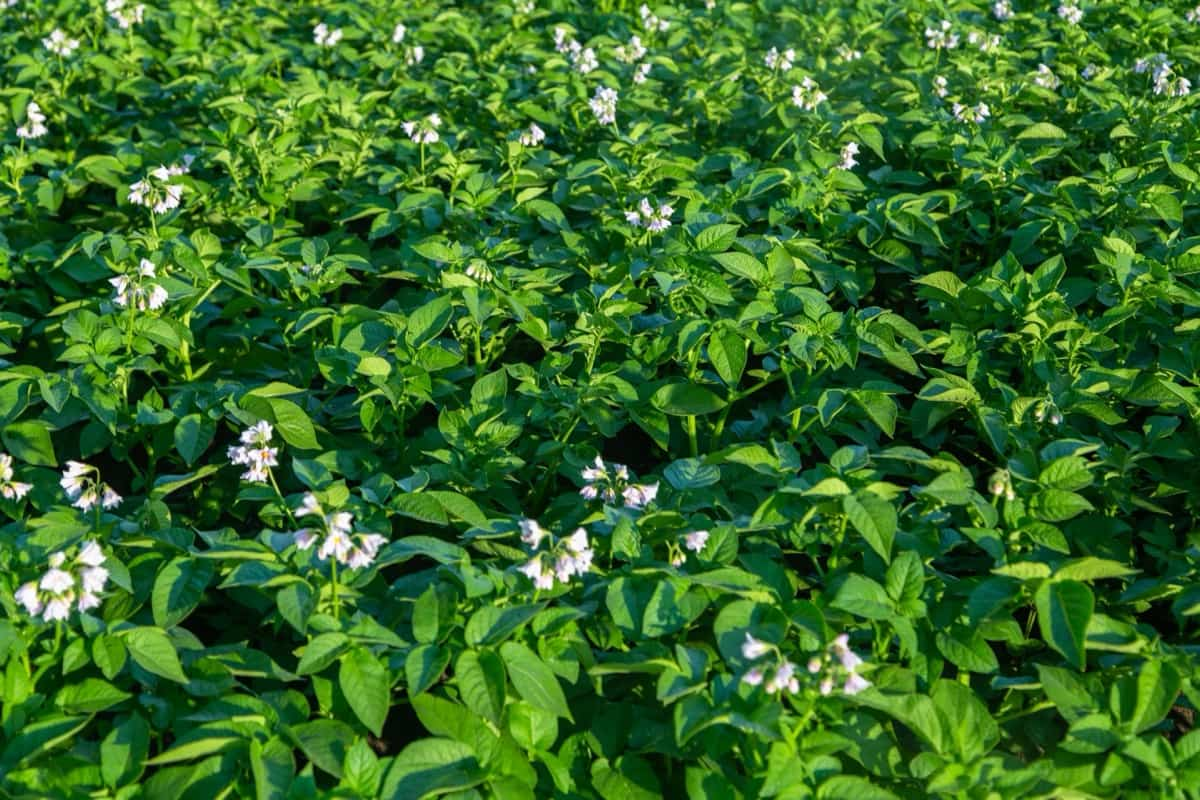
Preplant and Postplant Herbicides (Before Weeds Emerge)
- Dimethenamid-P (Outlook): Apply preemergence following planting or after dragging off.
- EPTC (Eptam 7E): Apply and immediately incorporate before or after planting. It can be applied again at layby.
- Flumioxazin (Tuscany SC): Apply after hilling but before potatoes emerge.
- Metribuzin (TriCor DF): Pre-plant incorporated broadcast spray or impregnated on dry fertilizer.
- Pendimethalin (Prowl H2O): Apply before potato emergence.
- Rimsulfuron (Matrix SG): Apply after hilling or drag off before potatoes emerge.
- S-metolachlor (Dual II Magnum): Apply preemergence and sprinkle or incorporate after hilling.
After Weeds Emerge Herbicides
- Clethodim (Intensity): At least seven days between cultivation and application for grasses.
- Glyphosate (Roundup): Apply low rates before potato emergence.
- Metribuzin (Tricor DF): Rate can be split between two applications, 14 days apart.
- Paraquat (Gramoxone SL 2.0): Apply before potato emergence.
- Rimsulfuron (Matrix SG): Apply when weeds are small (< 1 inch high).
FAQs Related to Weed Management in Potato Crop
How Can I Control Weeds in My Potato Crop Safely?
Use herbicides like EPTC, dimethenamid-p, and pendimethalin before planting, and consider crop rotation to reduce weed populations.
When Should I Apply Herbicides for the Best Weed Control?
Herbicides are most effective when applied before potato emergence or after planting, depending on the herbicide.
Can I Use Herbicides After Potato Plants Have Emerged?
Some herbicides like clethodim and glyphosate can be used postemergence, but they work best on small, actively growing weeds.
In case you missed it: Fertilizer Management in Potatoes: Organic, Compost Manure, NPK, and Schedule
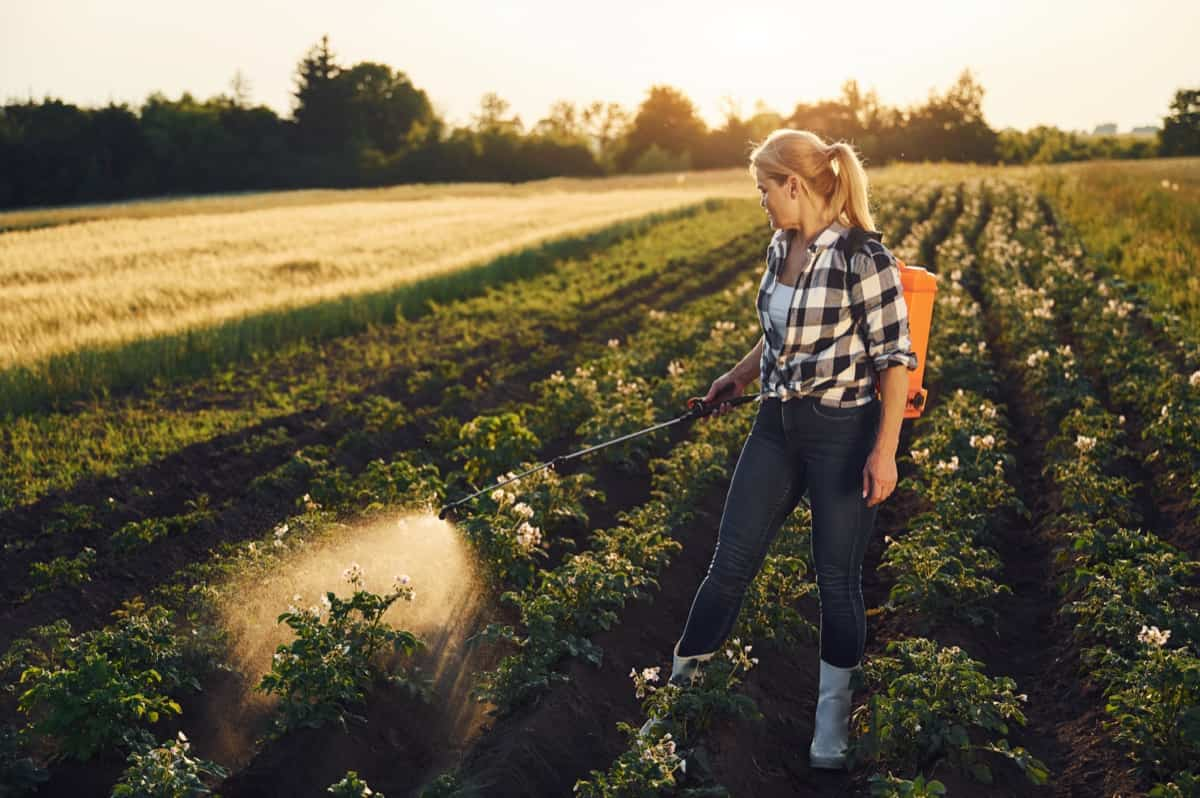
Conclusion
Effective weed management is crucial for successful potato farming. Identifying common weeds and using safe herbicides is key. Preplant and postplant herbicides, applied at the right times, can help control weeds. Selecting the appropriate herbicides and following recommended practices is vital for a healthy potato crop.
- Types of Pesticides Used in Agriculture: A Beginner’s Guide
- Economical Aquaculture: A Guide to Low-Budget Fish Farming
- 15 Common Planting Errors That Can Doom Your Fruit Trees
- How to Make Houseplants Bushy: Effective Tips and Ideas
- Innovative Strategies for Boosting Coconut Pollination and Yield
- Pollination Strategies for Maximum Pumpkin Yield
- The Complete Guide to Chicken Fattening: Strategies for Maximum Growth
- Natural Solutions for Tulip Problems: 100% Effective Remedies for Leaf and Bulb-Related Issues
- Revolutionizing Citrus Preservation: Towards a Healthier, Greener Future
- Natural Solutions for Peony Leaf and Flower Problems: 100% Effective Remedies
- Maximizing Profits with Avocado Contract Farming in India: A Comprehensive Guide
- Natural Solutions for Hydrangea Problems: 100% Effective Remedies for Leaf and Flowers
- The Ultimate Guide to Choosing the Perfect Foliage Friend: Bringing Life Indoors
- From Sunlight to Sustainability: 15 Ways to Use Solar Technology in Agriculture
- The Ultimate Guide to Dong Tao Chicken: Exploring from History to Raising
- The Eco-Friendly Makeover: How to Convert Your Unused Swimming Pool into a Fish Pond
- Mastering the Art of Delaware Chicken Farming: Essentials for Healthy Backyard Flocks
- 20 Best Homemade Fertilizers for Money Plant: DIY Recipes and Application Methods
- How to Craft a Comprehensive Free-Range Chicken Farming Business Plan
- Brighten Your Flock: Raising Easter Egger Chickens for Beauty and Bounty
- How to Optimize Your Poultry Egg Farm Business Plan with These Strategies
- Subsidy for Spirulina Cultivation: How Indian Government Schemes Encouraging Spirulina Farmers
- Ultimate Guide to Raising Dominique Chickens: Breeding, Feeding, Egg-Production, and Care
- Mastering the Art of Raising Jersey Giant Chickens: Care, Feeding, and More
- Ultimate Guide to Raising Legbar Chickens: Breeding, Farming Practices, Diet, Egg-Production
- How to Raise Welsummer Chickens: A Comprehensive Guide for Beginners
- How to Protect Indoor Plants in Winter: A Comprehensive Guide
- Ultimate Guide to Grow Bag Gardening: Tips, Tricks, and Planting Ideas for Urban Gardeners
- Guide to Lotus Cultivation: How to Propagate, Plant, Grow, Care, Cost, and Profit
- Agriculture Drone Subsidy Scheme: Government Kisan Subsidy, License, and How to Apply Online
- Ultimate Guide to Raising Araucana Chickens: Breed Profile, Farming Economics, Diet, and Care
- Bringing Hydroponics to Classroom: Importance, Benefits of Learning for School Students
- Ultimate Guide to Raising Polish Chickens: Breed Profile, Farming Economics, Diet, and Care
- Ultimate Guide to Raising Australorp Chickens: Profile, Farming Economics, Egg Production, Diet, and Care
- Silkie Chicken Farming: Raising Practices, Varieties, Egg Production, Diet, and Care
- Sussex Chicken Farming: Raising Practices, Varieties, Egg Production, Diet and Care